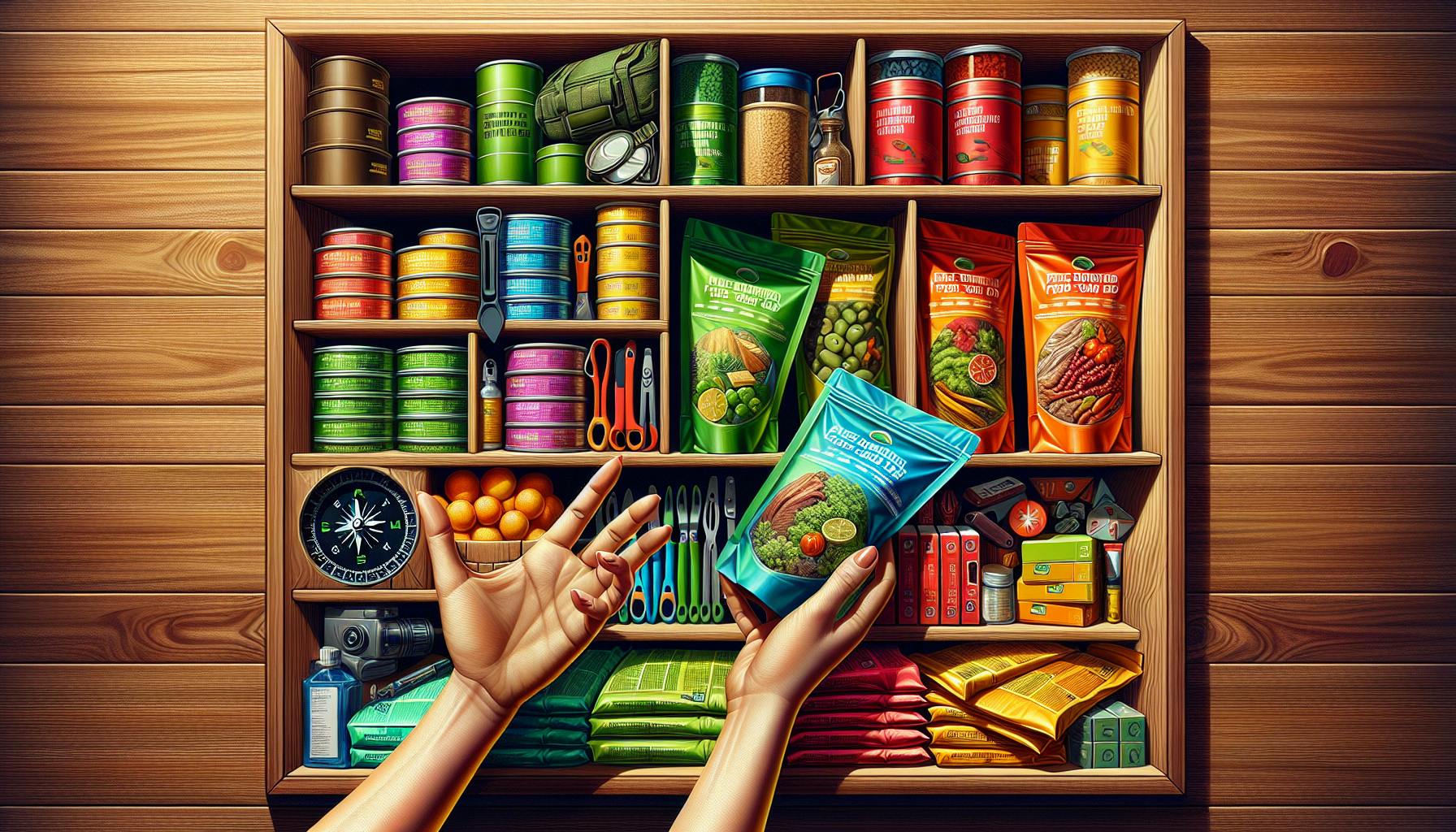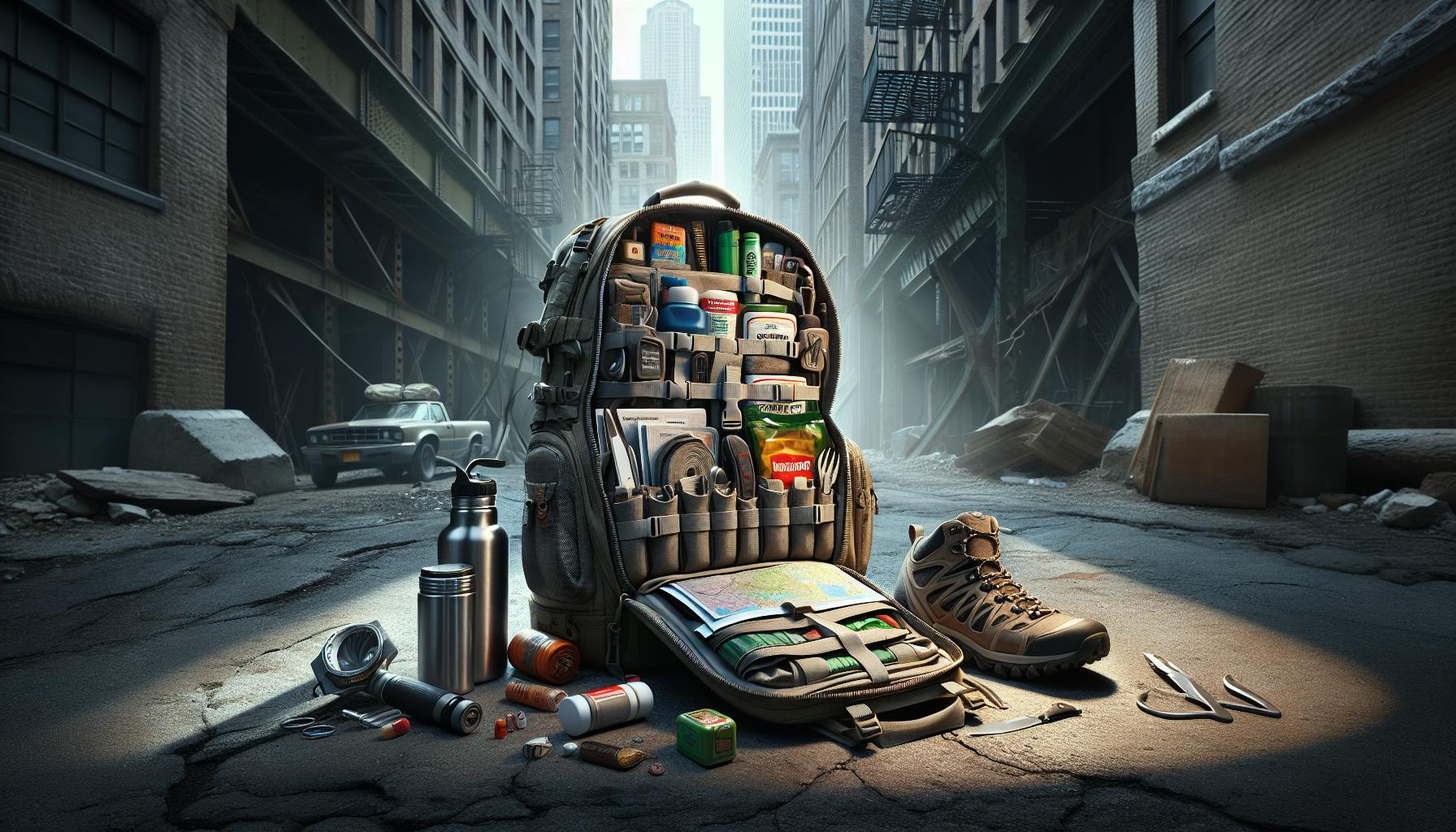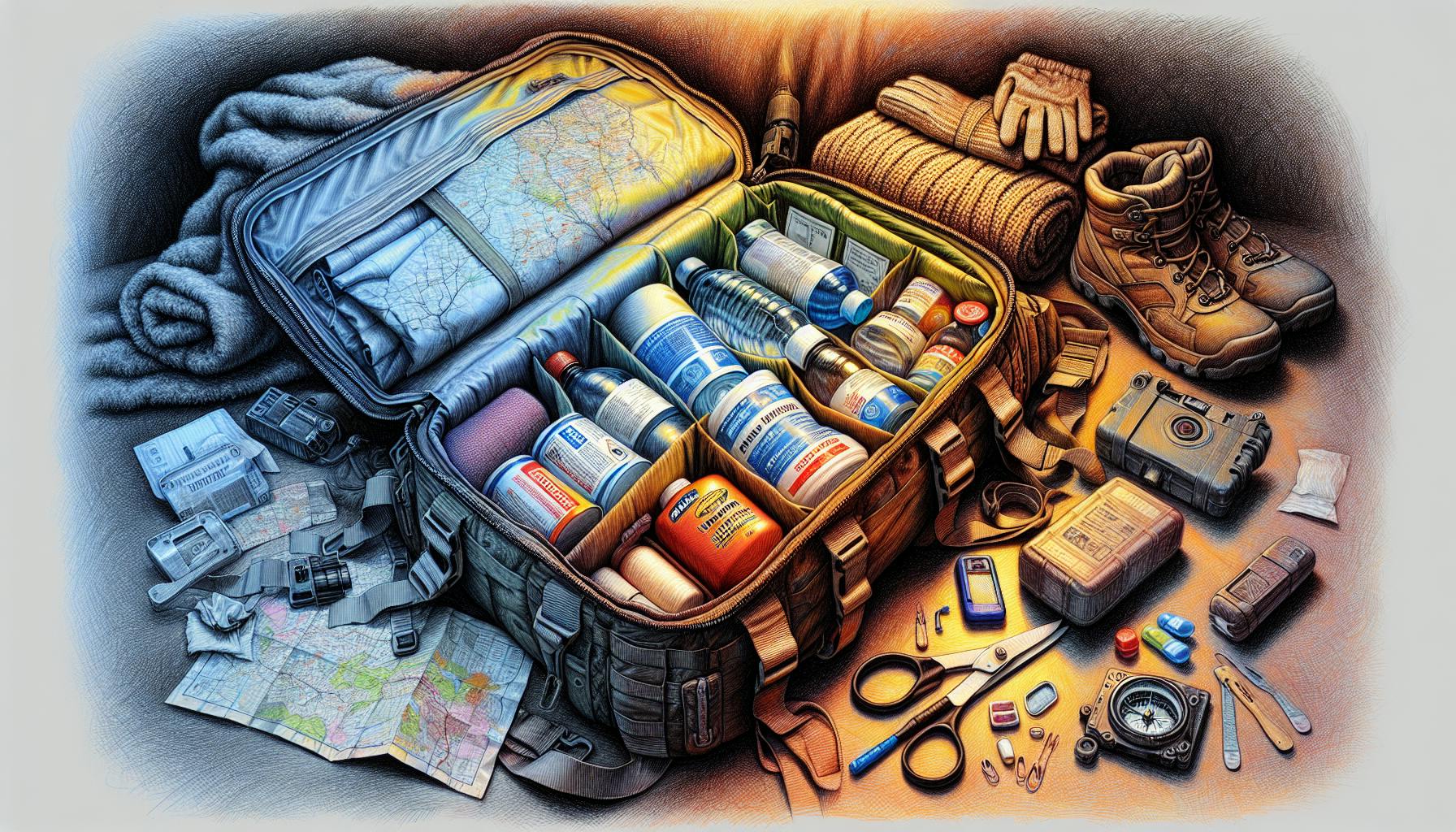When crisis strikes, having a well-stocked first aid kit can mean the difference between life and death.
This guide will provide you with a comprehensive list of the absolute essential medical supplies your SHTF first aid kit needs to handle any emergency situation.
You'll learn the core components your kit should contain, critical tools and instruments you may require, essential medications and antibiotics to have on hand, and specialized supplies to manage severe trauma cases. We'll also cover personal protection equipment, storage solutions, and how to customize your kit for your unique needs.
Introduction to SHTF First Aid Preparedness
Having a well-stocked first aid kit is essential for emergency preparedness. When SHTF (slang for "stuff hits the fan") and you lose access to medical care, being able to treat injuries and illnesses at home can save lives.
This article will cover the basics of putting together your own comprehensive SHTF first aid kit. We'll go over must-have supplies like bandages, medications, instruments, and more. By the end, you'll understand the essential items your survival medical kit needs and be ready to face emergency scenarios.
Understanding the Basics of SHTF First Aid
The fundamentals of first aid remain the same whether you have access to professional medical care or not. The key is being prepared to assess injuries, treat immediate life-threatening problems, prevent further harm, and promote recovery.
Having the right supplies on hand lets you handle issues from minor cuts and scrapes to broken bones, infections, and chronic conditions. Failing to plan ahead puts you and your loved ones at risk if pharmacies close or hospitals reach capacity.
Prioritize supplies to stop bleeding, immobilize fractures, fight infection, manage pain, and meet other basic needs. Customize your prepper first aid kit based on your family's demographics, health issues, skills, and likely risks.
Components of the Best Survival Kit
A well-stocked SHTF medical kit has instruments for diagnosis and treatment, medications, wound care supplies, tools and protective gear, copies of medical records, references, and more.
Basic instruments include a thermometer, blood pressure cuff, stethoscope, flashlight, tweezers, scissors, safety pins, and tourniquet. Have a variety of bandages, gauze pads, wraps, tape, and topical antibiotics. Medications treat pain, inflammation, infection, allergies, gastrointestinal issues, and chronic conditions. Include electrolyte mixes, medical gloves, sterile saline, a surgical mask, and other key supplies.
Research and test gear ahead of time. Rotate stock, track expiration dates, and refresh your skills. With preparation, you can handle medical situations when professional care is inaccessible.
The Core of Your SHTF First Aid Kit
Bandages and Dressings: The First Line of Defense
Having a variety of bandages and dressings is essential for stopping bleeding and protecting wounds in emergency situations. Here are some recommended supplies:
- Sterile gauze pads in multiple sizes - 2x2, 4x4, etc. These can be used to apply direct pressure to wounds.
- Rolled gauze - Flexible and can be wrapped around injuries. Useful for securing dressings or making compression bandages.
- Adhesive bandages - The familiar Band-Aids work well for minor cuts and scrapes.
- Butterfly closures - Help pull wound edges together for better healing. Good for minor lacerations.
- Trauma pads - Absorbent pads to stop heavy bleeding from major wounds. Essential for serious injuries.
Having an assortment of bandage sizes and types ensures you can effectively treat a wide range of wounds, from small cuts to more significant lacerations. Proper wound care is the first critical step in emergency medical response.
Antiseptics and Disinfectants: Preventing Infection
In survival scenarios, even minor wounds can quickly become infected without proper sanitation. Stocking antiseptic solutions is vital to prevent complications:
- Antiseptic wipes - Convenient individual packets to clean dirt and debris from wounds.
- Betadine - An iodine solution to kill microbes and prevent infection in injuries.
- Hydrogen peroxide - Can be carefully applied to fizz out debris in wounds when cleaning.
- Alcohol wipes - Useful for sterilizing medical equipment and skin around wounds.
- Antibiotic ointment - Helps prevent infection in abrasions and cuts after cleaning.
Thoroughly disinfecting wounds with antiseptics helps prevent bacteria and pathogens from gaining a foothold and causing infections. This buys precious time to get proper medical treatment.
Survival Medical Kit List: Must-Have Items
A well-stocked survival medical kit is a lifesaver in SHTF scenarios. Alongside bandages and antiseptics, be sure to include:
- Medical tape - Secures dressings and supports injuries.
- Trauma shears - Cut away clothing from wounds.
- Tweezers - Remove debris from wounds.
- Medical gloves - Protect yourself from bodily fluids and contamination.
- Sterile saline - Flush out wounds, eyes, etc.
- Basic medications - Painkillers, anti-inflammatories, antibiotics if possible.
- Emergency blanket - Prevents shock.
- First aid manual - Reference for treatment guidance.
Tailor your medical supplies to likely health issues given your situation. Be prepared to effectively respond to wounds, infections, burns, allergic reactions, breaks, sprains, and more. Your survival may depend on it.
Tools and Instruments for Medical Emergencies
Having the right tools and instruments in your SHTF first aid kit is critical for assessing medical situations and providing treatment during emergencies.
Diagnostic Instruments: Assessing the Situation
Being able to evaluate vitals and diagnose conditions is key to determining the right course of action. Essential items include:
- Thermometer: Take body temperature to check for fever indicating infection or heat stroke. A digital thermometer is recommended over mercury.
- Blood pressure cuff: Measure blood pressure to check for shock. Manual units are fine; automated not needed.
- Stethoscope: Amplify heart/lung sounds to diagnose issues like arrhythmias or pneumonia.
Surgical Tools: Handling Severe Cases
For severe lacerations, infections, or debris in wounds, having surgical items on hand is vital, like:
- Tweezers: Remove splinters, glass shards, stingers, ticks embedded under skin. Slanted tip design recommended.
- Scalpels: Make precise incisions to drain infections or debride wounds. Disposable #10 blades are easiest to stock up on.
- Irrigation syringe: Flush wounds to clean out bacteria, dirt, etc. 30mL+ size best.
The right diagnostic and surgical instruments enable you to effectively assess medical situations and provide appropriate care during disasters when professional help may not be available. Equipping your SHTF first aid kit with these basic tools allows you to handle a wide range of emergency scenarios.
Medication and Antibiotics: Treating Illness and Injury
Having the right medications and antibiotics is crucial for treating illnesses and injuries in a disaster scenario. Here are some key supplies to include in your survival medical kit:
Oral Medications: Ensuring a Range of Treatments
- Pain relievers like ibuprofen, acetaminophen, aspirin
- Anti-diarrhea medication
- Allergy medication
- Prescription medications
- Oral rehydration salts
- Cups, spoons, and oral syringes for administering liquids
Focus on stocking a variety of vital oral medications to treat common ailments. Ensure you have the supplies to properly measure and administer them.
Administering Injections: Equipment and Technique
- Various gauges of sterile needles and syringes
- Alcohol swabs to sterilize
- Tourniquet to locate veins
- Sterile vials and containers
- Injectable epinephrine, antibiotics, steroids
Having injectables and the ability to administer them sterilely is important. Practice injection techniques before an emergency.
Survival Medical Kit Antibiotics: Combatting Infections
- Amoxicillin to treat bacterial infections
- Antifungal cream to treat topical fungal infections
- Oral antifungal medication
Stock wide spectrum antibiotics like amoxicillin to fight infections when professional medical care is limited. Use antifungals to combat skin infections and thrush.
sbb-itb-b932644
Specialized First Aid Supplies for Severe Trauma
Having the proper supplies to treat severe trauma in a disaster scenario can mean the difference between life and death. Here are some critical items to include in your first aid kit to manage major bleeding and fractures.
Hemorrhage Control: Critical Bleeding Interventions
Controlling major bleeding is the top priority in a trauma situation. Be prepared with:
- Tourniquets to restrict blood flow to limbs for severe bleeds. Consider having both windlass and ratcheting designs like the CAT or SOFTT tourniquets.
- Hemostatic gauze like QuikClot combat gauze to quickly clot bleeding from wounds when direct pressure fails.
- Chest seals such as Hyfin Vent chest seals to cover sucking chest wounds and allow air to escape while preventing further damage and bleeding.
Having these supplies on hand can save a life by stopping uncontrolled hemorrhage during a SHTF scenario where immediate professional medical care is unavailable.
Fracture Management: Stabilizing Injuries
With no access to x-rays or surgery, properly stabilizing fractures becomes critical:
- Splints of various sizes can immobilize broken bones until they can be properly set. Consider SAM splints that can be molded as needed.
- Slings and swathes provide support for unstable shoulder and upper arm injuries. Triangular bandages work well.
- Elastic wraps like Coban self-adherent wraps securely hold splints and dressings in place despite movement.
Having basic fracture management supplies can reduce further tissue damage and pain until the bone can be properly realigned.
In any disaster medical situation, the goal is to stabilize the patient enough to transport them for advanced care. Having specialized supplies for severe bleeding and fractures may make the difference in saving a life. Continually train so you can use these first aid tools effectively when needed most.
Personal Protection and Hygiene in First Aid
When providing first aid, especially in disaster scenarios, protecting yourself from illness or contamination is critical. Having the right protective equipment and sanitization supplies can help minimize risks.
Gloves and Masks: Barriers Against Contamination
Wearing non-latex gloves, N95 masks, and eye protection creates a barrier between you and the patient, reducing the chance of exposure to bodily fluids or airborne pathogens.
- Include several pairs of non-latex exam gloves in your first aid kit. Nitrile or vinyl gloves are latex-free alternatives.
- N95 particulate respirator masks filter out airborne particles and microorganisms.
- Safety goggles or other eye protection prevent splashes or sprays of fluids into your eyes.
Sanitization Essentials: Keeping Your Kit Clean
Bringing soap, disinfectants, and a sharps container helps sanitize your hands, equipment, and disposal of hazardous items like used needles.
- Pack antibacterial wet wipes and hand sanitizer containing at least 60% alcohol to clean hands and surfaces.
- Use a 10% bleach solution or EPA-registered disinfectants to sanitize equipment.
- Needles, syringes, and lancets should go in a puncture-proof sharps container for safe disposal.
Following contamination prevention guidelines reduces disease transmission when providing first aid to others in a crisis. Packing the right protective gear and sanitizers keeps both you and your patients safe.
Integrating First Aid with Essential Survival Gear
Ensuring your first aid kit integrates seamlessly with other critical survival items is key to forming the best possible survival kit. Selecting multipurpose tools and strategic storage solutions helps achieve this goal.
Multipurpose Tools: Beyond Medical Needs
When building your first aid kit, prioritize items that can serve multiple purposes beyond just medical needs. Useful multipurpose tools include:
- Knives - In addition to cutting bandages, a good knife has countless uses for shelter building, food prep, and defense. Opt for a fixed blade over a folding knife for maximum durability.
- Fire Starters - Fire is critical for sterilizing medical equipment, boiling water, and warmth. Have multiple fire starting methods like matches, a flint striker, and a magnesium bar.
- Duct Tape - Duct tape has a myriad of medical and non-medical uses, from securing bandages to repairing gear. It's a true multipurpose survival item.
Carefully choosing multipurpose first aid components expands your survival capabilities exponentially.
Strategic Storage Solutions: Protecting Your Supplies
Properly storing your first aid kit is vital to keeping supplies protected and organized for quick access when needed. Key considerations include:
- Weatherproof Containers - Select a durable, waterproof container like a Pelican case to shield contents from rain, snow, etc.
- Customizable Storage - Opt for a modular, customizable system with removable compartments to organize items.
- Portability - Have a case with a shoulder strap or handle to easily transport your first aid kit on the move if bugging out.
Investing in the right storage solutions will pay dividends by keeping your invaluable supplies protected and within reach when every second counts during an emergency.
Tailoring Your SHTF First Aid Kit to Specific Needs
As you build your SHTF first aid kit, it's important to tailor the contents to your specific situation and needs. Simply copying someone else's kit won't ensure you have what's necessary for your circumstances.
Assessing Your Unique Situation
Consider the following factors as you determine what should go in your custom medical preparedness kit:
- Group Size: The number of people you need to be equipped to treat will impact the supply quantities you stock. Plan for more bandages, medications, etc. if in a larger group.
- Skills & Training: The medical expertise within your group dictates what you'll utilize from the kit. Focus on items you have knowledge to use appropriately.
- Environment & Hazards: Prepare for likely injuries from your geographic area, climate, bug-out location hazards, etc. Variations in potential wounds and illnesses will shape optimal kit contents.
- Likely Injuries & Conditions: What types of wounds, ailments and scenarios does your risk assessment indicate you should handle? Customize for higher probabilities like burns, infections, sprains based on your situation.
Re-evaluate as group members, locations, and needs shift over time. What suffices today may not tomorrow if circumstances change. Adapt accordingly.
Maintaining and Updating Your Kit
To ensure your first aid kit remains ready and effective when needed:
- Check expiration dates quarterly, replacing anything expired or soon expiring.
- Note when items are used and replace them promptly so the kit stays fully stocked.
- Research innovations in gear, medicine, and techniques to upgrade with better solutions.
- Cycle equipment to keep familiar with kit contents functionality in case of emergency need.
Staying current on latest best practices combined with vigilant maintenance keeps your lifesaving SHTF medical provisions prepared. Tailor it to you, trust it when required.
Conclusion: SHTF First Aid Kit Essentials Recap
Having a well-stocked first aid kit is an essential part of emergency preparedness. When SHTF scenarios occur, quick access to medical supplies can make all the difference.
Here is a brief recap of some of the most vital items to include in your SHTF first aid kit:
- Bandages and gauze - Various sizes of bandaids, gauze pads, rolled gauze, and medical tape to treat wounds and stop bleeding.
- Antibiotic ointment - To prevent infection in scrapes and cuts. Look for antibiotic creams containing bacitracin or neomycin.
- Pain medication - Ibuprofen, acetaminophen, aspirin to relieve pain and reduce fever.
- Wound closure supplies - Steri-strips or sutures to close large, deep cuts. Have the knowledge to use them properly.
- Gloves and protective equipment - Latex or nitrile gloves to avoid contact with bodily fluids. Safety goggles, CPR mouth barriers also important.
Having the right first aid supplies is crucial, but proper training and preparedness is also vital. Regularly review your medical kit contents and ensure you know how to properly utilize all items. Attend first aid classes focused on emergency scenarios. Being ready to administer quick, effective medical care during disasters can save lives.


